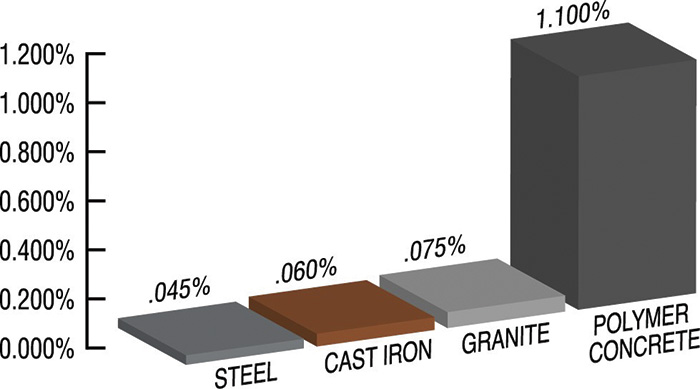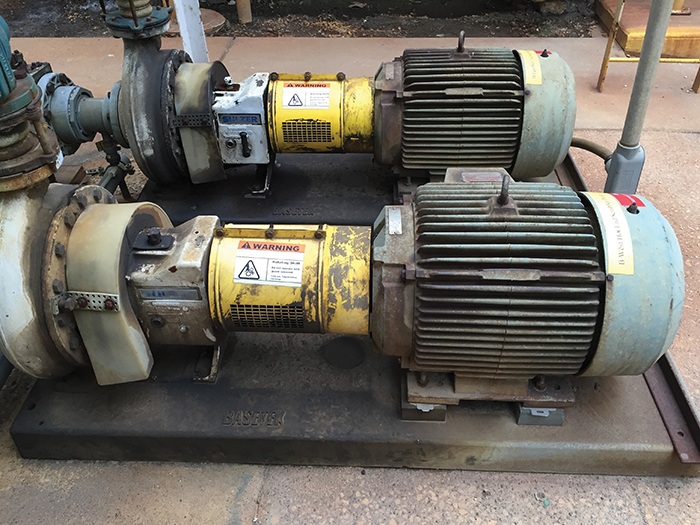The success of rotating equipment often can be traced directly to the surface and structure quality on which it is mounted. The useful life of seals and bearings in most process pumps is compromised when shafts are misaligned or excess vibration is present.
Some estimate that more than 80 percent of sealed centrifugal pumps are pulled from service for an issue with a mechanical seal or bearing. A solid foundation can increase the mean time between planned maintenance for pumps and most other types of rotating equipment.
 Figure 1. Damping ratio of typical baseplate materials (Graphic and image courtesy of BaseTek)
Figure 1. Damping ratio of typical baseplate materials (Graphic and image courtesy of BaseTek)While many features and options can be incorporated into a pump baseplate, experts will typically agree on the following minimum requirements:
- Mounting surfaces should support the entire pump and driver continually through the operating range of the equipment.
- Baseplates should be stiff enough to resist distortion and deflection and maintain alignment of the pump and motor when installed properly per design.
- Driver and pump mounting-pad surface flatness should be parallel within 0.002 inch per foot (0.15 millimeters [mm] per meter).
- Final alignment should be maintained by allowing up to a 0.125-inch shim pack (3 mm).
- Mounting hole requirements, including size and location, should never present a bolt-bound condition that inhibits final alignment procedures.
Typical equipment baseplates and foundations can easily become compromised for a number of reasons.
Incorrect or failed grouting systems common with a hollow metal or cast-iron base can quickly cause excess vibration frequencies that vary by rotational speed, temperature, and equipment forces and moments.
Less expensive, non-reinforced metal bases can also warp and bend during shipment, requiring additional labor to straighten, or they are often installed with such deviations.
Corrosion and other forms of environmental deterioration of the mounting base or underlying foundation can create an unstable and varying mounting surface that can result in excess vibrations and cause misalignment of installed equipment.
Baseplate failures are often difficult to identify in the field but can be correlated to reoccurring performance issues in the mounted equipment. Identifying and eliminating hidden mechanical defects in baseplate systems can save time and frustration in root-cause evaluations.
Historically, baseplates have been constructed of metal and either cast or fabricated to meet specific design requirements. Inexpensive, hollow, cast-iron designs along with channel and bent/formed steel options often twist or diaphragm during shipment and may require surface preparation or large amounts of grout to complete the installation. Rarely do these designs maintain a tight flatness tolerance. More complex metal-fabricated designs provide increased rigidity and surface flatness but may still require a significant amount of grout to complete a reliable installation.
A popular alternative gaining ground in the pump industry is the use of solid polymer concrete baseplates. They provide the benefits that reliability engineers desire at an economical installed price point.
In addition to a flat vibration damping surface, the corrosion-resistant solid material can easily incorporate drip pans, containment rims, higher-alloy threaded hole inserts and alignment devices.
Often referred to as a polymer, granite or mineral cast baseplate, this material is a special combination of well-defined grain size aggregates bound to a thermoset epoxy or vinyl ester resin. Manufactured in a controlled environment during a transfer molding process, these materials can be cast to precision tolerances and offer high mechanical properties suitable for most industrial applications.
 Image 1. Pumps at a sulfuric acid regeneration facility in Toledo, Ohio
Image 1. Pumps at a sulfuric acid regeneration facility in Toledo, OhioPolymer Concrete Benefits
Vibration damping:
The polymeric matrix of the material provides damping ratios that are 20 to 30 times greater per identical geometry than steel or cast-iron materials (see Figure 1). Rotating equipment is often associated with stability under the influence of various disturbances, and polymer bases can effectively minimize vibrations without increasing the component's mass size.
Precision mounting:
Cast mounting surfaces are typically flat within 0.002 inches per foot, which reduces soft-foot and speeds alignment. Threaded insert holes are typically cast in place or located with a computer-numerical-controlled machine to ensure precise location and perpendicularity, which eliminates bolt-bound conditions often occurring with inexpensive metal bases. Difficult-to-machine features can easily be cast in place, and maximum design flexibility allows for retrofit to any existing concrete foundation.
Corrosion resistance:
Advanced resin systems along with inert natural aggregates provide excellent protection from many fluids that would otherwise require an expensive alloy or corrode standard cast iron or steel. Polymer concrete systems eliminate the need for additional protective coatings or periodic upkeep and maintenance activities.
Faster installation:
Polymer concrete baseplates will not twist, bend or diaphragm like some metal designs. This eliminates the need for field adjustment during installation. Most designs also incorporate threaded leveling inserts along with a bottom surface ready for adhesion to grouting like in a conventional hollow design.
Grouting a polymer concrete baseplate requires considerably less labor and material. Grouting a hollow steel frame often requires greater skill to ensure that all voids are eliminated as grout is intended to be in 100 percent contact with the underside surface for proper performance and vibration damping.
Because the solid pre-cast polymer concrete base will maintain structural integrity without requiring grout, many potential installation errors can be avoided.
Stilt mounting a polymer concrete assembly takes advantage of the structural stability of the mounting surface while allowing the equipment to react to the forces and moments of the piping system.
Polymer concrete materials also offer low levels of heat conduction, act as an excellent electrical insulator, are non-magnetic and resist water absorption. Mechanical properties are suitable for most indoor-outdoor environments found in process industries.
Case Study
Chemtrade Logistics operates a sulfuric acid regeneration facility in Toledo, Ohio, with more than 96 process pumps in service. Four years ago, its annual seal replacements were in the range of eight to 10 per month. A concentrated program was initiated to focus on both equipment alignment and vibration reduction.
The first step was to ensure a reliable foundation. The facility made numerous upgrades to convert to polymer concrete baseplates. The material is impervious to the acid, and installers who used the threaded leveling inserts were impressed at how easily they could use a minimal amount of thin-set grout material to adhere the new base to the existing concrete pad. Minimal surface prep was only required on the concrete pad.
The team completed proper alignment between pump and motor shafts according to the pump manufacturer's recommendations, not the coupling manufacturer's, which typically allow for successful coupling operation at much larger tolerances. While upgrading baseplates, the installation team took care to eliminate excessive forces and moments in the piping, install expansion joints and ensure a minimum of five pipe diameters of straight piping preceding the pump.
Accurate equipment hole locations along with an extremely flat mounting surface made Bluetooth-enabled precision laser alignment quick and easy. Quarterly, handheld, five-point vibration monitoring confirmed and reinforced all foundation and equipment mounting changes that were made.
After completion of these upgrades, seal life increased dramatically. The change-out dropped from a monthly average of between eight and 10 units to between 0.5 and one. The plant realized sizeable reduction in seal cost and was able to shift labor to other critical areas.
Chemtrade Logistics is continuing its evaluation and replacement of baseplates in conjunction with proper alignment techniques.
A department emphasis has been placed on precision maintenance training to continually reinforce these solid plant practices.


